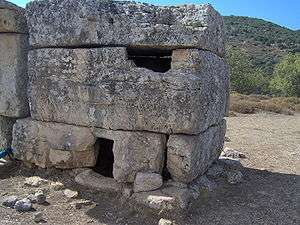Shammai

Shammai (50 BCE – 30 CE, Hebrew: שמאי) was a Jewish scholar of the 1st century, and an important figure in Judaism's core work of rabbinic literature, the Mishnah.
Shammai was the most eminent contemporary and the halakhic opponent of Hillel, and is almost invariably mentioned along with him. Although they were contemporaries, Hillel was nearly sixty years old at the time of Shammai's birth in ~50 BCE. Shammai founded a school of his own, known as the House of Shammai, which differed fundamentally from that of Hillel; and many of Shammai's direct sayings are thought to be embodied in those handed down in the name of his school.
History
Shammai's school of thought became known as the House of Shammai (Hebrew: בית שמאי, Beit Shammai), as Hillel's was known as the House of Hillel (Beit Hillel). After Menahem the Essene had resigned the office of Av Beit Din (or vice-president) of the Sanhedrin, Shammai was elected to it, Hillel being at the time president. After Hillel died, circa 20 CE, Shammai took his place as president but no vice-president from the minority was elected so that the school of Shammai attained complete ascendancy, during which Shammai passed "18 ordinances" in conformity with his ideas. The Talmud states that when he passed one of the ordinances, contrary to the opinion of Hillel, the day "was as grievous to Israel as the day when the [golden] calf was made" (Shabbat, 17a). According to most opinions, the ordinances, which are listed in an appendix to the ArtScroll edition of the Mishnah of tractate Shabbos, dealt with ritual purity of the Terumah and increased separation between Jews and Gentiles.
Legacy
Hillel's grandson Gamaliel succeeded to the position of president after Shammai in the year 30, but the Sanhedrin would remain dominated by the house of Shammai until around 70 (see Council of Jamnia). A "voice from heaven" is said to have nullified the legality of the rulings of the house of Shammai (Yerushalmi Berakhot, 1:4), which is why Rabbinical Judaism follows Hillel.
Shammai took an active part in the political and religious complications of his native land. Of a stern temperament, he cultivated the characteristic of firmness and strictness in law in contrast to the tireless patience which is said to have distinguished Hillel. Once, when a gentile came to him and asked to be converted to Judaism (or Noahide monotheism as H. Falk argues) upon the condition of extreme brevity ("on one foot") which Shammai held to be impossible, he drove the brazen applicant away; whereas Hillel rebuked him gently by saying, "What is hateful to you, do not do to your fellow. This is the whole Torah. The rest is the explanation. Go and learn." The gentile subsequently converted (Shabbat, 31a).
Religious views
Shammai recommended a friendly attitude toward all. His motto was: "Make the study of the Torah your chief occupation; speak little, but accomplish much; and receive every man with a friendly countenance" (Avoth, i. 15). He was modest even toward his pupils.
In his religious views Shammai was known to be strict. He wished to make his son, while still a child, conform to the law regarding fasting on Yom Kippur (the Day of Atonement); he was dissuaded from his purpose only through the insistence of his friends (Yoma, 77b). Once, when his daughter-in-law gave birth to a boy on Sukkot (the Feast of Tabernacles) he broke through the roof of the chamber in which she lay in order to make a sukkah of it, so that his new-born grandchild might fulfill the religious obligation of the festival (Sukkah, 28a).
In the Midrash Sifre, Deuteronomy, § 203 it is said that Shammai commented exegetically upon three passages of Scripture. These three examples of his exegesis are: (1) the interpretation of Deuteronomy, xx. 20 (Tosefefta, Eruvin, iii. 7); (2) that of II Sam. xii. 9 (Kiddushin, 43a); and (3) either the interpretation of Leviticus, xi. 34, which is given anonymously in Sifra on the passage, but which is the basis for Shammai's halakha transmitted in 'Orlah ii. 5, or else the interpretation of Exodus, xx. 8 ("Remember the Sabbath"), which is given in the Mekilta, Yitro, 7 (ed. Weiss, p. 76b) in the name of Eleazar ben Hananiah, but which must have originated with Shammai, with whose custom of preparing for the Sabbath it accords.
| Jewish titles | ||
|---|---|---|
| Preceded by Hillel the Elder |
Nasi c. 20–30CE |
Succeeded by Gamaliel |
| Legal offices | ||
| Preceded by Menahem the Essene |
Av Beit Din 20 BCE – 20 CE |
Succeeded by |
See also
| Wikiquote has quotations related to: Shammai |
- Shammaite
- Mishnah
- Hillel and Shammai
- Kfar Shamai Israeli moshav named after Shammai
References
- ↑ Eric Meyers (2014). Steven Fine, Aaron Koller, eds. The Use of Archaeology in Understanding Rabbinic Materials: An Archaeological Perspective. Talmuda de-Eretz Israel: Archaeology and the Rabbis in Late Antique Palestine. Studia Judaica (Book 73). Walter de Gruyter. pp. 312–313. ISBN 9781614514855.
- Jewish Encyclopedia: Shammai
- Jewish Encyclopedia: Bet Hillel and Bet Shammai

![]()